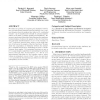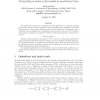303 search results - page 17 / 61 » Computing Minimal Spanning Subgraphs in Linear Time |
ADHOCNOW
2009
Springer
13 years 9 months ago
2009
Springer
We consider n mobile sensors located on a line containing a barrier represented by a finite line segment. Sensors form a wireless sensor network and are able to move within the lin...
COMPGEOM
2010
ACM
14 years 1 months ago
2010
ACM
We study the problem of computing the similarity between two piecewise-linear bivariate functions defined over a common domain, where the surfaces they define in 3D—polyhedral...
CORR
2007
Springer
13 years 8 months ago
2007
Springer
We analyse and compare the complexity of several algorithms for computing modular polynomials. We show that an algorithm relying on floating point evaluation of modular functions...
ASIAMS
2007
IEEE
14 years 3 months ago
2007
IEEE
This talk has two parts explaining the significance of Rough sets in granular computing in terms of rough set rules and in uncertainty handling in terms of lower and upper approxi...
NETWORKING
2007
13 years 10 months ago
2007
Abstract. We consider the problem of constructing a proxy-based overlay skeleton tree (POST) in the backbone service domain of a two-tier overlay multicast infrastructure. Spanning...


